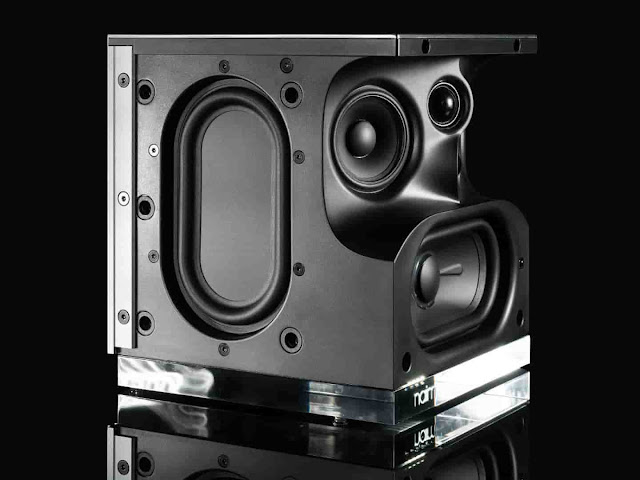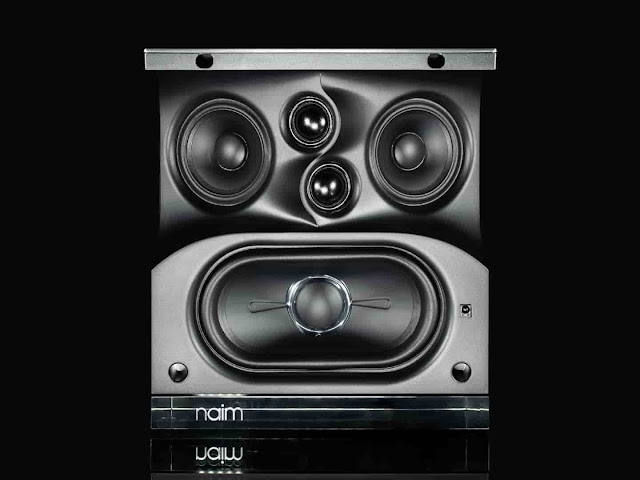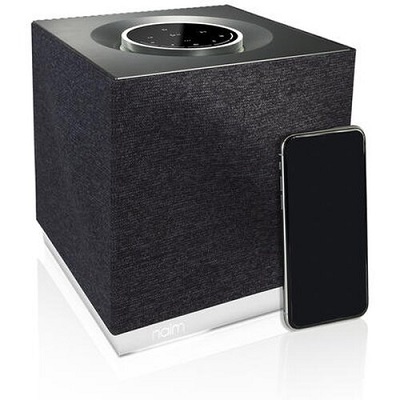Naim mu so QB 2nd generation review
The first version of the "cube" from Naim turned out to be almost perfect for its format, and, no matter what anyone says, even niche-forming or niche-reviving: thanks to it, equipment manufacturers began to rivet small high-fi boomboxes again. She had a voluminous, bright sound, excellent design, and the broadest functionality. There were, of course, features that had to be put up with. But it’s not for nothing that the company released the second generation of Mu-so Qb, right?
The rich inner world, v2.0
Most of the changes in the small Mushi, like the big one, are concentrated inside. Visually, it is not easy to distinguish the first version from the second one: the updated model is issued only by the volume control wheel, which is affably illuminated when you bring your hand to it.
And so - it's still the same aluminum cube, covered on three sides with a slightly wavy protective grille and mounted on a transparent base with an illuminated Naim logo. At the back are a large radiator grille and connectors - power, Ethernet, USB, optics, and 3.5 mm, as well as a hole for resetting the settings.
The speakers hidden under the grill look the same as the first version of the Mu-so Qb, but in reality, they are just the same shape and in the same places. The story is similar to the big Mu-so - they worked on the speakers together with Focal engineers. Drivers load five class D amplifiers: 100 watts are directed to the woofer on the front panel, and four times 50 watts are distributed between pairs of tweeters and midranges. All active speakers are located on the front panel, but on the sides of the volume, passive radiators are added to the sound.
A lot of attention was paid to DSP in the new version - it is smarter, more powerful, faster. With it, you can adjust the sound of Mu-so Qb depending on the position in space - in the corner, against the wall, away from them. The DAC was also installed newer, now it perceives a signal of 24 bit / 384 kHz. The main difference from the previous model is the extended network functionality. Firstly, there was support for Naim's proprietary multi-room, which combines all modern Naim devices with some kind of network connection into one system. Secondly, there is a Chromecast on board, AirPlay 2, which we recently talked about in great detail, Spotify Connect, Tidal, Roon support, UPnP connection to sources, and, of course, Bluetooth with Internet radio.
If you think about it, the list of differences between generations is not so great. The case is actually the same, except that it has been slightly redesigned from the inside. Well, yes, Wi-Fi is more powerful, DSP is more impressive. Are these improvements really necessary?
The first impression is deceptive
"Musya" played badly. At least at the very beginning of the test. High frequencies whistled, there were too many of them, while it was almost impossible to hear even a hint of more or less tangible rhythms.
It turned out that the one who listened to it before me turned on the "Loudness" function - which is just famous for raising high and low frequencies. Yes, at low volume it allows you to better distinguish dialogues and rhythm, but starting somewhere from 25% it already spoils everything and creates exactly the same effect as described above - it whistles, screams, loses bass, and breaks all hopes. As soon as it was turned off, the sound already became much closer to how the first version of Mu-so Qb, which I knew well, played.
But something was still missing. Playfulness, maybe? Joy? There was a lot of sharpness and clarity, the presentation itself seemed even, maybe even unnecessary. Do you know what the problem was? Again, lack of rhythm.
The new "musya" turned out to be quite strongly directed in the vertical plane. If it plays below ear level in the near field, then most of the dynamics disappear from the sound, which is primarily created by the rhythmic component. This point must be taken into account. Moreover, if it plays below the level of the ears, but far away, everything is fine, the whole room is filled with an evenly perky sound. But at a distance of one and a half meters, the directionality is very well felt.
It can be said that my acquaintance with the “musea” did not work out for me, but after we sat down comfortably relative to each other, she completely rehabilitated herself. I started with a relatively layered piece, the Watchmen soundtrack, which was worked on by Trent Reznor and Atticus Ross. It suits Mu-so Qb's handwriting perfectly: driving, clear, varied, and very emotional in itself. Properly placed “musya” can win back all this without problems, adding a plus to the whole volume.
But it was not easy for her to cope with Nine Inch Nails themselves - nevertheless, their sound is a bit dirty for her and she cannot adequately decompose this music into components so that it does not come out as a hodgepodge. There is more minimalism in the Watchmen soundtrack, more precision - that's why the "cube" has no problems with it. Slightly lacking density bottoms, but they are readable and sloppy.
In general, "Musa" is good at music, in which attention needs to be regularly switched to high-frequency effects located on a dense rhythmic substrate - like The Crystal Method, Pendulum, various cheerful electronics. On Pendulum, the lack of bass even disappeared somewhere and a pleasant, soulful punch appeared. But its most important feature is that it is loud. During the test, I hardly twisted the volume above half - she calmly sounded the entire demo room, especially, it seems, without straining. The ideal volume for her is 30-40 percent.
Here I want to step away from the music a bit and kick the Naim app for Android. Maybe I was unlucky, but there were problems with volume control. In order to change the volume, the slider at the bottom of the screen had to poke five times - he did not want to be captured and dragged. There was also such a funny bug when listening through Tidal: if you turn on the melody, lock the phone, wait for the next track in the list to start playing, and after unlocking the phone and getting into the Naim app, then “musea”, after a little thought, switches to the previous track. But this is just an application - it can always be completed, updated, repaired.
What exactly is good with “music” is the transfer of emotions. In the track "7 Billion People All Alive at Once" from And So I Watch You From Afar, the guitar waltz motifs were served in a relaxed, gentle, and kind way, but another track from these guys, "Set Guitars To Kill", on the contrary, was filled with life, power - but, however, not completely. It seems that the "muse" lacks a little dope as if she is afraid to be mischievous in full force. On the same track, by the way, the hypothesis about the device’s dislike for a dirty guitar sound was confirmed: when two guitars, rhythm and solo, start playing after a loss, it’s almost impossible to separate them from each other in the “muse” sound, they mix too tightly.
But, for example, “Front/10” from the Linkin Park remix album sounds absolutely beautiful. A minimalistic beat, slightly tinted with distortion, distorted voices - that's all. There are few components in the melody, there is nothing to mix - therefore there are no problems. The same story, by the way, with the piano performed by Hazel Scott. Rustling old recordings of an unrealistically fast game, in which there is nothing else besides the piano and the crunch of interference, the “music” served clearly, almost warmly, without losing speed, maybe only slightly embellishing the distortions, but without clogging the overflowing sound of the keys with them.
But, for example, in the tracks of Too Many Zooz, she paid a lot of attention to percussion, sometimes almost covering it with a rustle of an insufficiently hysterical saxophone. This could be attributed to the peculiarities of mixing the track because the emphasis on rustling and tapping in the composition "Mouse Trap" is heard on other systems, but "musya" highlights it more.
The volume of the "cube" was perfectly revealed on the almost spontaneous vocals of Björk and Florence Welch. Listening to the album "Ceremonials" while sitting on the floor in front of the "Musei" standing on the coffee table is some kind of almost ephemeral, slightly ancient pleasure. The scene turns out to be wide, yes, painted with large strokes, but for such a crumb it is very serious. It has a lot of air, openness, which is only good for vocals like Björk and Flo and simple instrumental compositions. In such a scene, the details that Mu-so Qb gives out in full are much more accurate.
a little bit better
The changes in the second generation Mu-so Qb are small but important - more streaming, more processing power, more quality, more convenience. With the latter, I agree with caution: yes, the new control wheel is wonderful, but the application, and especially the integration of Tidal into it, needs work. Also, by the way, the kit comes with remote control - simple, but neat.
As for the sound... Mushi has all the features you need to ruin it. If you do not use them and keep the "cube" at the height of the ears or at a distance of more than two meters, then everything will be fine. Within, of course, the format of the system.
There is a lot of sounds - it is big, wide, loud. Maybe a little squeezed in the low-frequency range - but this is still a small Naim, not a lifestyle JBL. You should be more careful to include multi-layered melodies, the “musya” can choke on them. Her path is, first of all, it seems to me, emotional minimalism. It can be fast, it can be calm, gentle, or aggressive - but keep it simple.
We can say that Naim, with the release of Mu-so Qb, revived the niche of stylish high-fi boomboxes. The new version of the "cube" has become only more modern, without changing the sound principles laid down in the first model. And that's great.
Naim Mu-so Qb 2nd Gen music system Specifications
size, stage volume, detail, updated volume control, the recognizable sound signature
not so noticeable differences from the first generation Mu-so Qb, unoptimized application, strong dependence on the height position when listening in the near field
$1,199.00 / Amazon
Analog input: 3.5mm jack
Format: three-way audio system; two tweeters, two mid-range drivers, one woofer, two passive radiators
Digital interfaces: optical input S/PDIF (TosLink), up to 96 kHz, Ethernet 100 Mbps, Wi-Fi (802.11a/b/g/n/ac) 2.4 GHz, USB, Bluetooth LE 4.2
Streaming Sources: Apple AirPlay 2, Chromecast, UPnPTM, Spotify Connect, TIDAL, Roon Ready, Internet Radio
File formats: WAV, FLAC, AIFF - up to 24bit/384kHz, ALAC (Apple Lossless) - up to 24bit/384kHz, MP3, AAC - up to 48kHz, up to 320kbps (16bit), OGG, WMA - up to 48 kHz (16 bit), DSD - 64 and 128
Internet radio streaming formats: Windows Media, MP3, ACC, Ogg Vorbis, MMS
Features: audio system with DSP, sound optimization depending on the location in the room (in free space, against the wall, in the corner), comes with a remote control
Amplifier power: 4 x 50 (HF and MF) + 100 W (LF)
Power Consumption (Typical): 15W
Dimensions (mm): 210 x 218 x 212
Weight: 5.6 kg













.jpg)



.jpg)



0 Comments